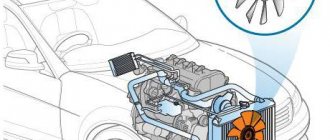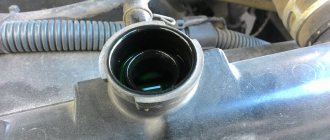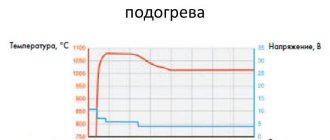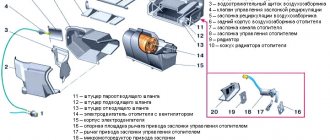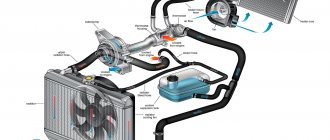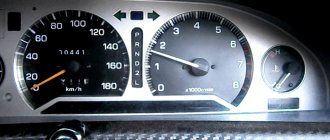Simplified operation of the VAZ 2114 cooling system
Cooling diagram for VAZ 2114: 1 – element in the form of a plug for the expansion tank;
2 – expansion tank; 3 – hose for draining liquid from the pipe; 4 – hose passing between the radiator and the expansion tank; 5 – hose leading from the radiator; 6 – tank to the left of the radiator; 7 – aluminum tube; 8 – plug systems; 9 – tank to the right of the radiator; 10 – drain plug; 11 – middle of the radiator; 12 – casing for electric fan; 13 – plastic wings of the electric fan; 14 – electric motor; 15 – toothed pump pulley; 16 – pump impeller; 17 – camshaft drive belt; 18 – engine block; 19 – pump pipe; 20 – radiator hose with supply function; 21 – heater radiator hose with drain function; 22 – hose supplying coolant to the throttle pipe; 23 – exhaust pipe; 24 – hose for refilling; 25 – heater radiator hose with supply function; 26 – thermostat; 27 – coolant temperature sensor; 28 – coolant level indicator sensor. The coolant enters the water jacket of the engine block through the pipes. In the water jacket, the coolant circulates in a small circle until the engine (and therefore the coolant) reaches a temperature of 95 degrees Celsius.
At this moment, the thermostat opens and coolant is delivered through the pipes to the radiator. The radiator removes excess heat from the coolant. Excess hot coolant returns to the expansion tank.
The entire cooling system is under high pressure of 1.2-1.8 atmospheres, due to the operation of the pump and the increase in coolant volume due to heating.
From the above text we conclude: malfunctions of the cooling system are not easy to detect with small leaks, since the coolant evaporates almost immediately, having a high temperature, and work to find the location of the leak sometimes requires the intervention of a professional.
Attention!!!
All work on the cooling system must be carried out with the car turned off and the coolant cooled down.
Step 1. The pipe burst
Since the pipes are the “blood vessels” of the car, failure of any of them will result in loss of coolant.
This malfunction is clearly visible on a warm engine while driving. A large amount of steam appears from under the hood. The burst pipe is clearly visible.
But there are times when the coolant leak is small. Then, first of all, attention should be paid to the articulation of the pipes with the vehicle components.
When using coolant in the form of antifreeze or antifreeze, a characteristic oily coating remains in the leak areas.
Step 2. Radiator problem
A radiator malfunction is extremely difficult to detect. At the site of a coolant leak, a large amount of scale sometimes forms, making it difficult to see the location of the damage.
Pay attention to the tightness of the filler plug. If everything is OK with the tightness, then to check you will need a compressor with a pressure gauge or a pump.
Disconnect the upper pipe and connect the compressor. The pipe must be plugged. We create excess pressure and see where the leak appears. We dismantle the radiator. We take it to a specialized service center, where they will check it again under pressure, find a leak (there may be more than one) and weld it with a special compound.
Step 3. Gases in the expansion tank
This malfunction occurs due to the entry of exhaust gases (a specific smell is clearly felt in the car interior) into the cooling system under enormous pressure of 90-96 kPa.
The reason is a faulty gasket between the valve head and the cylinder block. It is caused by coolant leaking from under the expansion tank cap.
The check is quite simple. We start the engine on a cold car, remove the cap from the expansion tank and sharply press the accelerator (in common parlance, the gas pedal).
If the coolant rises sharply, the gasket must be replaced. Stop operating the vehicle immediately until the problem is resolved.
Sometimes the expansion tank cap, due to spring wear, may not withstand coolant pressure.
We recommend reading: Antifreeze in oil
Step 4. Gray emulsion instead of oil
If you notice that your car has started to “trouble”, a large amount of steam comes out of the exhaust pipe, which smells like coolant. The amount of coolant is constantly decreasing and when checking the oil dipstick, it is clear that the oil has turned into a gray emulsion.
All this indicates a malfunction of the cooling jacket of the engine cylinder block. I categorically do not recommend operating the car in this condition! In addition to the problem with the cooling system, the lubrication of all moving parts of the engine is impaired, which can easily lead to its breakdown.
Step 5. Antifreeze in the cabin
In addition to cooling the engine, the coolant is used to heat the vehicle interior. If the interior radiator or the pipes leading to it malfunction, a large amount of coolant leaks onto the floor.
The malfunction is very unpleasant, as it entails disassembling almost the entire front part of the car's interior.
The main causes of antifreeze leaks
There is certainly a problem with age, but it is negligible, therefore, the reason will most likely lie elsewhere; below we will try to figure out why coolant leaks occur.
The reason that coolant may leak can be due to many malfunctions, and the main one is wear of the cooling radiator or heater radiator.
Traces of smudges are a reason to be wary
This happens because the coolant contains harmful substances that destroy the radiator honeycomb . In addition to these reasons, the cooling radiator is actively affected by external irritating factors, such as weather and high humidity, which can result in corrosion and destruction of the main parts of the radiator.
Other causes of leakage
Let's consider less common situations.
Expansion tank
Coolant reservoir leaking. The location of the leak is marked with an arrow in the photo.
It happens that the expansion tank installed on a VAZ-2114 undergoes decomposition due to the presence of various alcohols in the coolant. This composition has a negative effect on the tank and can simply corrode its body. When such a malfunction occurs, a coolant leak is accompanied by a pungent odor and white vapor , which can even penetrate into the interior of the car.
The old one cracked and leaked, they installed a new one with article number 21083-1311014
Another sign of a malfunctioning expansion tank is the appearance of traces of antifreeze or antifreeze under the driver’s feet.
Coolant hoses
The photo clearly shows the “snotty hoses”
Another reason why coolant may leak is damage or rupture of the hose in the places where they are connected.
A similar situation often occurs on VAZ-2114 produced in the first years of its production, as well as on cars that have not been serviced for a long time. This happens because worn hoses are simply worn out, and due to the influence of negative temperatures they cannot withstand the pressure and burst. It is for this reason that it is recommended to replace all hoses every 2 years .
It is very easy to identify damage to a hose or cooling radiator, since drops or a puddle of coolant will remain on their surface. Drops can be located not only on individual parts of the engine, but also on the floor or ground while the car is parked.
Pump depressurization
Traces of a leaky pump gasket are not visible to the naked eye.
Fix it yourself or go to a service station?
Once again I want to draw your attention, this is very important! All work on replacing cooling system elements is carried out exclusively with the engine turned off and the coolant cooled down.
You can replace the pipes, thermostat, radiator filler cap, and expansion tank cap yourself. Remove the filler cap on the radiator. Unscrew the drain plug on the engine and drain the coolant into a clean container.
As for replacing the gasket between the valve head and the piston block, repairing a rotten engine cooling jacket and repairing radiators, these works are best done at specialized stations.
Since such repairs will require the use of specific tools and the necessary experience and knowledge.
Purpose of the cylinder head gasket
This gasket is located between the cylinder head and the block itself. The head is also commonly called the cap. The importance of this detail is difficult to underestimate:
- The cylinder head gasket maintains the tightness of the block.
- Organizes the flow of a mixture of gas and air in one direction - into the combustion chamber.
- Separates circulating fluids - coolant, oil and fuel.
The performance of all these functions is necessary for the performance of any internal combustion engine.
Several important nuances when choosing cooling system components
The most important thing is to use special antifreeze or antifreeze liquids, which have a higher boiling point.
Choose pipes from well-known manufacturers, do not skimp on this. Especially when making replacements inside the car.
Replace the expansion tank cap only with the original one. Do not reduce the number of coils of the spring, they are designed for a certain pressure. It is important!
When replacing the radiator and thermostat, pay special attention to the volume and response temperature. This is critical for proper engine operation. Excessive or too low temperatures will lead to either overheating of the engine, or it will not heat up to operating temperature at all.
Coolant replacement
First of all, you need to drain the old antifreeze through the drain hole in the radiator. In this case, it is necessary to protect the generator from liquid ingress. You can speed up the draining process by removing the lid from the tank.
Attention! If the drained antifreeze is green, then it cannot be used because it has lost its cooling properties.
- Remove the heating pipe for the throttle body.
- Fill the liquid slightly above the level indicated on the reservoir.
- Press the nozzle to pump out the air.
Thus, detecting a leak in a VAZ-2114 is quite simple. You just need to carefully inspect the cooling system. And fixing a leak will not be a problem for an experienced car owner.
How does poisoning occur?
Immediately after taking ethylene glycol, a short-term state of mild alcoholic intoxication may occur. A person can fall asleep or feel quite satisfactory for 8-12 hours without noticing the first symptoms of poisoning.
After 12-15 hours, symptoms develop that indicate a deterioration of the condition:
- severe headaches
- dizziness, loss of coordination of movements
- attacks of nausea, vomiting
- sharp and/or cramping pain in the abdomen, lower back, and muscles
- flickering of “flies” before the eyes, objects are seen unclearly, double, short-term onset of blindness
- the surface temperature of the skin decreases, it becomes pale or gray, so-called “marbled”
- spasms of the upper and lower extremities
- lowering blood pressure
- severe stimulation of the nervous system or the onset of a coma
